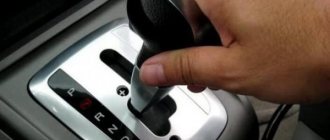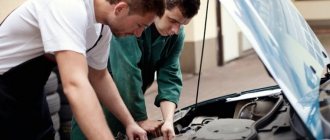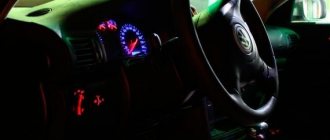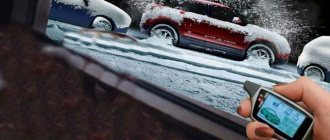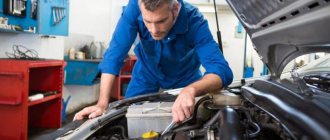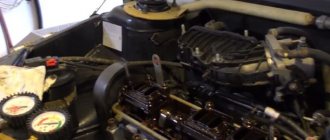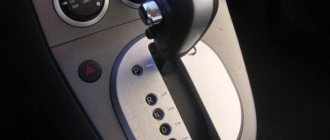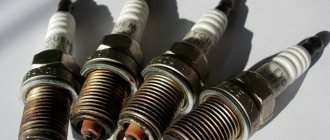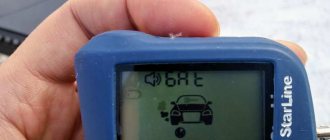Riding style
Speaking about why the car jerks when starting from a stop, we need to start with the obvious. The very first and most obvious reason is a harsh clutch. If you start, add gas and suddenly release the clutch pedal, the car will definitely jerk. Therefore, first of all, you need to try to change your driving style. At a minimum, when starting off, you need to release the clutch pedal very slowly and add a little more gas. However, you shouldn't press the gas pedal too hard.
However, if with an automatic transmission the car jerks when starting, then you won’t be able to change your driving style here, because there is simply no clutch pedal. But even with a manual transmission, the problem may be different. If the car still jerks even when starting smoothly, the problem is clearly not a sudden grip of the clutch discs.
The car jerks due to faults in the manual transmission
For normal movement of a car with a manual transmission, constant gear shifting is required. The main rule of manual cars is to switch the lever on the box in time and correctly. If you violate the sequence, you can quickly wear out the parts and simply bring the car in for repairs.
In the case of a manual transmission, when changing gears, the car jerks due to the actions of the driver. What should you not do if you are still driving a manual car? First of all, it is necessary to choose the right time to press the clutch pedal and change gears. Do not delay the transition to high gears, and after switching to it, avoid sharp pressure on the gas pedal. The most important thing is that there is no need to press the pedals randomly at speed; every action should be thought through or you will cause damage to your car.
External and internal CV joints
If some suspension parts are poorly secured, then when driving (especially during a sharp start), they can cause the car to jerk. First of all, you need to check the inner and outer CV joints. The inner CV joint transmits rotational energy from the gearbox to the axle shafts and then to the wheels. This element is quite important, and if problems arise with it, it must be changed. This can be done at any service station. Features of failure of the inner CV joint are as follows:
- When destroyed, the inner CV joint becomes loose and can turn when transmitting forces, especially at the start.
- On a straight road without the smallest potholes, the inner CV joint can knock. In this case, it will seem that a dull knock is coming from the wheels.
- Outer CV joints may crunch when turning. If destroyed, they can also cause the car to jerk when starting off.
- Usually, internal CV joints simply wear out and because of this they fail. However, rarely the gearbox can cause a breakdown of this unit. This happens in cases where there is something wrong with the box itself.
- Outer CV joints can break due to impacts or careless driving on a bad road.
If your VAZ car jerks when starting from a stop, then first of all you need to check the CV joints. Often on forums when discussing a similar problem, users point to this particular node. Considering the prevalence of these cars and the cheapness of spare parts, repairing this element is unlikely to be expensive. It is worth noting that a similar problem occurs on the VAZ-2114 car. When starting off, the car jerks, but after replacing the CV joint (“grenade”), the problem disappears.
You will be very lucky if the problem turns out to be in the car's CV joints. These are inexpensive items that are easy to replace. It is much worse if a fault is discovered in the gearbox.
Why does the car jerk while driving?
Author Pavel Aleksandrovich Belousov Reading time 7 min. Views 509
The situation when a car starts to move unevenly is familiar to every motorist. The problem, which manifests itself in jerking and jerking, can be caused by the incorrect operation of various automotive systems. Today we will look at the common symptoms of this “disease” and share recommendations for eliminating them.
So, a violation of the smoothness of the ride and the associated jerks of the car occur:
Determining the culprit of the malfunction
The car can “twitch” while driving for various reasons, so you should adhere to a certain troubleshooting algorithm. If there are no obvious signs of transmission malfunction, then first of all we check the power and ignition system.
Failures in the engine power system
Malfunctions in the system for preparing and supplying the fuel mixture are indicated by jerking of the machine in motion. In this case, the malfunction can manifest itself in different ways:
As you can see, uneven engine operation can appear both when the crankshaft speed changes sharply or smoothly in one direction or another, or when operating at stable speeds. The reason for these phenomena is a simple lack of combustible mixture, due to which the engine simply cannot develop power sufficient to overcome the resistance of the transmission.
To eliminate negative phenomena, we check several main components of the power system:
1. Filter. Even with a working fuel pump and a clean fuel line, the engine will begin to starve if the fuel filter is clogged with dirt. The way out is to replace or clean the filter element - it all depends on where exactly the blockage occurred. The fact is that car engines have several cleaning elements installed along the fuel path. If you are dealing with an injection internal combustion engine, then you should pay attention to the third filter element located after the fuel pump. Designed to separate the smallest particles, it clogs quite often, which is why the gas pump cannot pump the required volume of fuel through it. For carburetor cars, we check both the third filter installed in front of the carburetor, and the second one - it is located between the fuel tank and the fuel pump. If replacing them did not yield anything, then you should check the coarse filter installed on the fuel receiver. In addition, the cause of insufficient fuel supply may be the mesh located in front of the float chamber in the carburetor body.
Transmission problem
The gearbox may well be the reason why the car jerks when starting off. However, there should also be other signs of a gearbox malfunction: difficulty shifting all or any one gear, a strange sound from this unit, etc. If this happens on the “mechanics”, then the problem is not so bad. In this case, the box itself can be repaired, and due to the simplicity of its design, repairs will not be so expensive. But if this problem is in the automatic transmission, then this is already serious.
In first gear the car jerks and jerks may appear in second gear: possible causes
Quite often, while operating a car with different types of gearboxes (both manual and automatic), the driver may notice the appearance of jerks in first gear, as well as in second.
At the same time, in other gears the indicated jerks may be absent. There are also a number of cases where the problem is of a “floating” nature. In such a situation, jerks appear “cold” and/or “hot”, etc. Let us immediately note that there are several reasons for the appearance of such a malfunction, starting with the engine power system and ending with the transmission itself. In this article, we will focus on the gearbox, and also look at why the car jerks in first gear, why jerks occur in second gear, and what to look for when diagnosing problems.
Impact of jerks on the car
Whether jerking the car is beneficial or harmful is a rhetorical question. It’s the same as poking a person with a knife and asking if your health is improving. Any kind of jerking of the car is harmful, be it just a jolt when driving or a consequence of changing gears.
The main impact falls on the transmission unit and the engine part. First of all, the load on moving elements (bearings, switches, gears) increases. Each impact can deform, leave a crack or completely break any of these elements. Repairs can take a long time and cost the car owner a significant amount of money. That is why it is important to initially determine the reason why the car began to twitch and eradicate it.
Article on the topic: Robot and automatic transmission: which one to choose and what is the difference?
Do they repair gearboxes?
In any case, you will have to go to a service station, where they will examine the car and issue a conclusion. If the automation fails, repairs will be quite expensive. However, if any gear from the mechanism breaks down, the box, in principle, can be disassembled and a separate element replaced, but this is also a rather painstaking and complex procedure, and it costs money.
Note that quite often service stations do not undertake to repair automatic transmissions at all. Often they are simply replaced, but there are craftsmen who agree to restore these units, which allows the owner to save money.
What's the result?
As you can see, if a car jerks in first gear or a car jerks in second gear, there can be quite a few reasons. If we talk about the transmission, often with manual transmissions and many types of robotic gearboxes, a common cause is a worn clutch (both as a whole and individual elements) or malfunctions in the actuators responsible for the operation of the clutch on a manual transmission.
In the case of hydromechanical automatic transmissions, diagnostics are greatly complicated by a large number of sensors and the presence of a torque converter, which is a separate element. For this reason, it is recommended to carry out comprehensive computer diagnostics of the automatic transmission, as well as perform a number of tests and checks, which are carried out by experienced automatic transmission repair specialists at specialized service stations.
Finally, we note that if the owner notices that the car begins to jerk in first gear, the car jerks in second speed, etc., it is better not to delay in determining the cause. On the one hand, quick troubleshooting will allow you to avoid more serious problems and costly breakdowns, but on the other hand, jerking and jerking in the first and second gears can cause accidents and other troubles on the road.
Source
Steering
If the steering rack is faulty, it may well jerk when starting to move. Worn elements of this mechanism are usually not repaired - they are replaced with new ones. Also, the steering rack tips can dangle freely in their positions, which will cause jerks when accelerating sharply and when braking. In this case, the steering wheel wobbles. Damage to the steering column cannot be ruled out (usually this occurs in an accident), which can also create jerks when moving or starting.
If the steering mechanism is faulty, the driver should feel vibrations in the steering wheel, and not just jerks when starting off. And again, nothing can be advised to the driver regarding self-repair. Understanding the steering mechanism is no easier than understanding the gearbox system. So you have a direct route to the service station.
Fuel system
If the fuel mixture is supplied to the combustion chambers of the engine in the wrong amount, jerking may occur when driving. This can happen if the car owner fills the tank with poor quality fuel or gasoline that the car is not designed for. For example, if a Euro-4 or Euro-5 engine is supplied with fuel with a high sulfur content (92 gasoline), it will wear out quickly. Some injectors may also become clogged, causing the wrong amount of fuel to be delivered. This can lead to jerking at start, but the “symptoms” can be different: loss of power, detonation, increased gas consumption.
Why does the car move jerkily when changing gears?
Opinions among car enthusiasts differ regarding the reasons why jerks occur when shifting gears. So, some believe that this is mainly due to driving with a cold engine. Others argue that if the gearbox is handled correctly, nothing like this happens, citing the beginner’s inability to use a manual transmission.
Do jerking damage the technical condition of the machine?
Jerks that occur while driving cause serious damage to the parts responsible for the operation of the transmission and engine. The moving elements suffer the most from this:
- Bearings.
- Gears.
- Switches.
Long-term operation of the car in such conditions will inevitably lead to the occurrence of malfunctions, the elimination of which will cost a pretty penny. To restore normal operation, you need to determine what exactly caused these anomalies.
Jerking due to motor failure
Often the cause of jerking is unstable engine operation, which occurs due to incorrect distribution of the air-fuel mixture. In the case of old cars, the problem is often the low quality of spark plugs: if they give a weak spark, then the fuel does not burn completely. As a result, problems begin in the operation of the cylinders, which is why jerking occurs.
If we talk about modern cars equipped with an injection engine, then the appearance of a jerk may be due to the following reasons:
- Malfunction of the speed sensor and, as a result, errors in the operation of the on-board computer.
- Failure of the idle speed sensor, which is responsible for stabilizing engine speed.
- Clogged intake injector nozzles, complicating the access of the combustible mixture into the combustion chamber.
- Incorrectly adjusted compression in the cylinders.
- Gaps and delays in fuel ignition due to cable wear.
In addition to technical factors that can lead to the car starting to twitch, there is another one - the quality of the fuel. Using good fuel will minimize the likelihood of many problems occurring.
Jerks caused by problems in the transmission unit
The car may jerk while driving when:
- Inconsistent gear shifting.
- Untimely pressing of the clutch pedal.
- Selecting a gear that does not correspond to the speed limit.
- Sharply pressing the accelerator pedal when changing to a higher gear.
Taking into account the specifics of the above reasons, it becomes clear that they are all caused by errors made by the driver. Remember that improper operation will result in increased wear on the transmission and engine. Therefore, do not be lazy to improve your driving skills.
The car jerks in first gear or second speed: fault diagnosis
As mentioned above, in such a situation, the first step is to gradually eliminate problems in the power supply system, ignition, as well as failures in the ECM. For example, a common reason when the car jerks at low speeds when engaging first and/or second gear is insufficient fuel/air supply to the engine or impaired mixture formation.
The result is that the engine is unstable, the unit in different modes does not have enough power to “turn” the box, which leads to noticeable jerks in movement. The culprit of the problem may be air leaks, contamination of the injection nozzles or fuel pump mesh, or problems with the carburetor.
Various ECM sensors (Hall sensor, TPS, mass air flow sensor, etc.) can also malfunction. If everything is fine with the sensors, then you need to check the engine ECU. Quite often, the problem of jerking in 1st-2nd gear is directly related to the ignition. It is necessary to check the condition of the spark plugs and high-voltage wires, distributor and other elements on a particular machine.
As a rule, if the car drives jerkily, in relation to injection cars, specialists conduct comprehensive computer diagnostics of the engine. If such a check does not produce results or the cause is not found, then the vehicle’s transmission deserves special attention.
- So, if your car is noticeably jerky in 1st and/or 2nd gear, it is important to understand that the transmission may also be causing the car to jerk when driving. At the same time, it is easier to determine the cause in the case of a manual transmission, while various types of automatic transmissions require more serious checks.
Let's start with the manual transmission. Please note that if an inexperienced driver's car jerks in first gear when starting off, it should be taken into account that often beginners simply make mistakes when releasing the clutch, while the car itself is working properly.
To start without jerking, you need to smoothly release the clutch before the driver feels the grip point (the beginning of the transmission of torque from the engine to the wheels). After the force begins to be transmitted to the wheels and the car begins to move, you need to carefully add gas, dosing the traction with the pedal accelerator.
If an experienced driver is driving, then he can quickly identify the problem. So, on cars with manual transmissions, the gearbox itself often has nothing to do with the problem of jerking in gears when driving. In other words, in cases of gearbox failure, other problems are noted when the gears may not engage, grinding, humming, vibration of the gearbox, etc. appear.
But jerking is usually caused by problems with the clutch on the manual transmission or its adjustments. For example, a car jerks in first and second when the clutch driven disc is badly worn, the clutch does not “close” completely, and slips. This leads to the car jerking when changing gears.
In this case, jerks most often appear precisely in “low” gears (first, second speed), when the smoothest possible operation of the clutch is needed and at the same time, through the clutch in these gears, a sufficiently large torque is transmitted from the internal combustion engine to the gearbox when accelerating the car.
- Now let's move on to automatic transmissions. First of all, you need to take into account that the quality of operation and smoothness of automatic transmission shifts will depend on the type of automatic transmission.
First of all, jerking can occur when driving with robotic gearboxes that have both one and two clutches. The fact is that the clutch of such gearboxes resembles in its design and principle of operation a conventional friction clutch of a manual transmission. Often the solution to the problem is to replace the DSG or AMT clutch, after which it is imperative to adapt the clutch (training, setting the grip point).
We also recommend reading the article about why there is a crunching noise in the gearbox. From this article you will learn about the reasons for its occurrence, as well as how to repair the gearbox.
Also, in some cases, the culprit that the car jerks when driving in 1-2 gears may be breakdowns and malfunctions in the actuators that are responsible for the operation of the clutch in automated mode.
As for CVT variators and hydromechanical automatic transmissions, in this case, when jerking occurs, in-depth diagnostics are required. The fact is that such gearboxes do not have a traditional clutch. In this case, the automatic transmission clutch is a separate device (torque converter), where torque is transmitted through transmission oil. In this case, the gas turbine engine may well fail, which becomes the cause of jerking.
It should also be noted that the automatic transmission itself can “slip”, and the quality of its operation greatly depends on the level/condition of the transmission oil (ATF fluid). Jerking in automatic transmissions of this type may occur due to insufficient or overfilled oil, the use of a lubricant with unsuitable properties, etc.
Jerking in a car with an automatic transmission in certain gears (especially during shifts) may indicate problems with the brake band, valve body, automatic transmission solenoids, sensors, separate automatic transmission ECU, etc. Taking into account the above, we can conclude that the machine needs to be checked comprehensively, paying special attention to the level of lubrication and the quality of the oil itself.
Problems with other elements
Quite often, Opel cars jerk when starting from a stop due to problems with the exhaust gas recirculation valve. This valve is a headache for many Opel owners with Ecotec engines. As a result of the formation of soot on the valve, it may simply become clogged, and then an incomprehensible mixture consisting of fuel, air and waste exhaust gases will enter the combustion chambers. This is fraught with loss of power, increased consumption and, possibly, jerks at start.
Therefore, it is very important to fill only high-quality gasoline, and not save on buying fuel suitable for your engine. The same can be said about oil. Under no circumstances should you fill in oil with the wrong viscosity or additives!
What causes the car to jerk when running at low speeds?
Since the car begins to twitch when reaching even low speeds, it will not be possible to immediately identify one specific problem. Problems may be hidden:
- In the engine fuel mixture supply system;
- In the vehicle ignition system;
- At the checkpoint;
- In the distributor design;
- Includes fuel filters;
- In the sparking system;
- In the control unit of the vehicle's on-board computer.
Let's go through the faults in each of the listed systems in detail.
Tip: When detecting a “jerking” behavior in the vehicle, the brakes may also squeak when braking. These 2 problems can be either interrelated or indicate completely different breakdowns.
Checking the engine fuel mixture supply system
Often the reason that the car jerks at low speeds is due to a malfunction of the power system. When the car starts to move, the cylinders simply cannot receive the required amount of fuel mixture, as a result of which the car is unable to transfer the required amount of power to the chassis for smooth driving and smooth commissioning of the transmission. As a result of increased pressure and transmission resistance, uneven running of the machine appears.
To solve this problem, it is recommended that you first pay attention to checking the throttle body. It also wouldn’t hurt to test and diagnose the performance of the sensors installed in the system for determining idle speed indicators. Do not forget to check the serviceability of the throttle valve position and the mass air flow sensor.
Throttle body
During diagnostics, most often a breakdown is found in the injectors responsible for uniform injection of the fuel mixture. In rare cases, engine jerking problems may be related to the air ducts that connect the injector receiver to the air filter structure. Here the problem lies in depressurization of connections and loss of pressure.
The solution to the problem is to replace all faulty components yourself or with the help of car service specialists. After repair, it is recommended to ensure that all connections are in good working order and that there is no loss of pressure in the fuel line system that is connected to the fuel pump itself.
If a power unit with a carburetor system was installed in the engine compartment of your vehicle, then you need to check the idle valve and the absence of damage directly to the carburetor.
fuel mixture
Checking the car's ignition system
Sometimes the car starts to jerk while driving at low speeds as a result of a breakdown in the ignition system. Basically, the problem will be caused due to untimely ignition of the fuel mixture and air flow. In rare cases, the malfunction may be hidden in the receipt of low voltage from the spark plugs. The spark voltage simply will not be enough to ignite the fuel mixture in a timely manner. Also, when diagnosing the ignition system, check:
- Performance of ignition coils;
- Serviceability of the spark plug set;
- No tears in high-voltage wires;
- There are no problems in the ignition distributor-interruptor (in simple terms - in the distributor);
- Correctness of values coming from a set of sensors responsible for the position of the camshaft and crankshaft;
- The performance of the switch located inside the entire structure.
Often, the car may jerk due to the long use of a set of spark plugs. There is often a situation where problems are caused by spark plug gaps not meeting established standards.
Advice: if the ignition module on a VAZ-2112 is faulty, the crankshaft position sensor will be damaged and it will not be possible to start the car’s engine at all. This problem can only be solved after a thorough check and subsequent repair of the knock sensor.
ignition coil
Checking the car gearbox
Jerking of a vehicle engine often occurs due to improper operation of the engine and infrequent maintenance of automatic transmissions. If the total mileage of your car is 100-200 thousand km, then even with a seemingly serviceable gearbox, the car will move with some jerks.
As a result of frequent jerking of the engine, the oil in the box foams, causing the amount of solution to be either too small or too large. Repairing a gearbox takes a little time. In a car service center, in just a couple of hours they will remove the box and restore its operation.
Transmission
Problems with the accelerator
At the moment when the driver sharply presses the gas pedal, a rapid increase in engine speed occurs, which, in turn, can lead to ineffective operation of the vacuum ignition angle regulators. As a result, at low speeds the distributor will sink, and the car will begin to move jerkily.
Since, with the gradual combustion of gasoline, the driver begins to increase engine speed, the engine must ignite and let in the fuel and air mixture even faster. If there is a problem with the vacuum regulators, the car will not be able to quickly increase speed, which will cause problems with opening the throttle valve. Without the simultaneous opening of the damper and air supply, gasoline will not be able to burn in time, which can ultimately lead to damage to the bearing, which is responsible for the ignition timing.
To solve the problem, the vacuum regulators are first diagnosed. Here you can independently remove all the hose and pipes, having previously tightly covered them with your hands. When the engine is running, you will hear the retracting effect of the regulators working. If a vacuum does not form when the air mixture is supplied, it means that the seal is broken precisely because of the damper. You should replace it and assemble all components in the reverse order.
"Brains" of the car
A special program decides in what proportion to mix fuel with air and feed it into the combustion chambers. If the program makes an error, then the engine will receive a mixture with an incorrect air/gasoline ratio, which can also cause the car to jerk when starting off. An oversaturated or undersaturated mixture may be fed into the combustion chambers, then a batch of normal mixture may enter the system, after which improper mixing occurs again - all of which can easily cause the car to jerk, both when starting and when driving at speed. This may also be accompanied by popping noises from the exhaust pipe or lack of engine response to the gas pedal.
Clutch failure
Often, jerking and jerking of the car when starting off occurs due to a clutch malfunction.
What may be faulty in the clutch mechanism:
- The driven disk is worn out (replace only).
- The disc hub is stuck on the transmission input shaft. The splines need to be cleaned. If this does not help, then replace the shaft or disk.
- The linings are worn out or their fastening is loose. The driven disk assembly is replaced.
- Window wear, broken or weakened springs. Disk replacement.
- Spring plates reduced elasticity. The driven disk must be replaced with a new one.
- The pressure plate or flywheel is scored. The clutch basket or flywheel needs to be replaced.
It is convenient to carry out repairs in a pit by lifting the front of the car. First, the starter, cardan and other parts are removed, depending on the design. After removing the gearbox, you can get to the clutch. Next, you need to remove the basket cover, flywheel parts, install a new disk and reassemble in reverse order.
Engine
Unfortunately, if the car jerks when starting off, the engine can also cause a similar phenomenon. Moreover, its different systems may be to blame for this. A distinctive feature of engine malfunction is jumps in crankshaft revolutions, which is easy to notice on the tachometer. In this case, the engine may not listen well to the driver: it may not respond to pressing the gas pedal, it may make noise.
View gallery
Diagnosing what exactly causes jerking is quite difficult. The problem may be in the fuel injection system. For example, if the injectors are clogged, then fuel will flow into one combustion chamber, but not into the other. There may also be disproportionate mixing of fuel with air, which will cause jerking not only when starting from a stop, but also when driving on a flat road.
How to prevent this?
The following tips are a little banal, but effective. At a minimum, you need to fill your car with high-quality gasoline with the correct octane number. The instructions for the car must indicate what fuel should be poured into the tank.
This also applies to oil. It is necessary to use only the lubricant recommended by the manufacturer. Taking into account the presence of counterfeit oils on the market and low quality fuel, it is necessary to change oils even more often than the car manufacturer recommends. At a minimum, after 8-9 thousand kilometers the lubricant must be replaced. This will extend the life of the motor.
In general, you need to operate the car carefully. If you put a heavy load on the engine at least once and heat it up to the “red zone” on the thermometer, then problems with the engine can arise constantly. In this case, jerking when starting is far from the worst problem.
Audi 100 1992, 133 l. With. - breakdown
Cars for sale
Audi 100, 1991
Audi 100, 1993
Audi 100, 1992
Audi 100, 1993
Comments 59
Volkswagen Tr.3 changed the 1.6 d. to a 1.9 turbo d. and a 5-speed gearbox. When starting off from 1-2 gears, there was a shaking scribe. I replaced the clutch disc, improvements appeared, changed the pillows, everything. Now everything is normal. Beauty.
Today we changed the clutch disc for a Vectra b 96g 1.7 td. So a couple of times while moving away I noticed a shaking. The reason is the drive itself. The new disk has softer springs. The seller said the clutch will be softer. Conclusion: na.bal)) such an experience
Why does the car jerk when starting off?
If the car starts to jerk while starting from a stop, the reason is usually due to a malfunction of the clutch or CV joints. In such cases, it is imperative to carry out diagnostics in order to immediately determine the breakdown and begin to eliminate it.
The main thing is not to panic, you need to make sure that before you start driving, the engine is warmed up to operating temperature, there are no problems with the ignition and the fuel supply system. If everything is normal here, then we need to further look for the cause.
Driving style
Inexperienced drivers often abruptly release the clutch pedal, causing the car to start jerking away. There are no malfunctions, you just need to change your driving style, learn to smoothly release the clutch and add gas at the same time.
It is necessary to determine the moment of clutch actuation on the car. To do this, start off without adding gas and smoothly release the clutch. Having determined in what position the clutch begins to engage, you can move away smoothly. On a car with an automatic transmission there is no clutch pedal. In order for such a car to move without jerking, the gas pedal must be pressed smoothly.
Search
Transmissions sometimes have problems with the clutch system. Necessary repairs must be made. But after replacing the clutch, car shocks or some new defects occur that have not been eliminated (vibration, noise, whistling, knocking). Let's try to talk about different dilemmas after changing the clutch and the reasons for the shortcomings. Write down right away that we will talk about cars.
Defects that occurred after replacing the clutch
What does it mean to change the clutch? This action is intended to replace the drive or drive coupling, often replacing both parts immediately. In this case, the exhaust bearing can also be replaced. After such an operation, side defects suddenly appear that were not there before the repair.
If justified, the circumstances surrounding the occurrence of new defects are insignificant. This is usually:
- Unqualified repairs;
- Lack of new spare parts;
- Misdiagnosis, as a result of which not all or the wrong parts were changed, and previously hidden problems made themselves fully known.
Generally speaking, the appearance of new unpleasant signs is very complex and individual in each case, but these signs have common features.
If the car locks after replacing the clutch
You may also like
- Nissan X-Trail Front Door Doesn't Open What should you pay attention to when choosing a Nissan X-Trail? There are no invasive machines out there, no matter what the advertising inspires us to believe. Tasks and disadvantages, special “sores” are available for each mechanism. Automobile. it is a collection of many devices...
- Repairing the BMW E39 Steering Rack With Your Own Hands
BMW 5 Series BUMER e39 pontoon cutter ›Logbook› Repairing the E39 steering rack Welcome to the BMW E39 Foundation and just lovers! I will tell you what needs to be done with our client in order. It started when our client left strange knocks on the front... - Removing the Ford Focus Pan 1
Removing the oil pressure sensor The sensor is removed for replacement in case of a malfunction, as well as to check the pressure in the engine oil line. We work on a ditch or overpass. Remove the engine hood (see “11.2. Ford Focus II. Removing the hood and fenders… - Replacing the Fog Light Bulb in Logan Lighting
the road while driving is extremely important. This directly affects the lives of the driver and passengers, as well as the lives of those sitting in oncoming vehicles, especially while driving on the road. And it doesn't matter which light is turned off. near… - Knocking When Pulling Off Niva Chevrolet
After writing this article, I was offered a post on one of the social networks. A man bought a Chevrolet Niva for himself, but when he drove it out of the car, he was confronted with his peculiarity. This function affects the transmission during startup and when shifting... - Nissan Almera Immobilizer Problem
Most modern car manufacturers install an immobilizer as an anti-theft system. Purpose of this device. block individual engine control circuits by turning on electrical relays. Usually relays are installed in the central...
For example, before the repair, the car did not gain speed, slid, and the clutch pedal worked at the top. All signs of a worn disc were present. After changing the drive, the car jerked. What can happen after repair?
- This may be a faulty part. Sometimes this is not the case when it comes to non-original spare parts. On Russian cars (VAZ, GAZ, AZLK, IL), defects also occur in industrial parts. In other words, the drive is simply wrong. In the clutch basket (drive disc), the particle pressure can be at different levels, then the compression occurs unevenly and the machine closes.
- The car can be turned by adjusting the clutch. More precisely, it was not done after replacing the disk. The lining of the last part is much thicker; in this case, the clutch pedal “takes to the very end”. When starting from a standstill, the car jerked and the gearbox crunched.
- The machine is closed due to the replacement of not all parts that required it. Namely, the worn surface of the flywheel under the driven disc is the cause of the impact. If the flywheel is not changed, shocks may occur while driving and the car may also move.
If there is a noise or whistling noise after replacing the clutch
Many motorists often complain that after a change there is a noise or whistle that was not there before. What are the reasons for third-party sounds and why does it happen?
- The new release bearing either did not meet the requirements or did not have factory lubrication. A whistling or noise occurs when the clutch pedal is pressed. Many people make the mistake of thinking that the bearing makes noise when the clutch is disengaged. But this is even illogical, in this state the part does not bear the load, and the noise (whistle) in this state is small.
- The clutch basket has a bulge and roughness at the ends of the pressure particles. Usually such a disadvantage is spare parts from Russian manufacturers. It should be emphasized that when the parts are grounded, the whistle that first appeared is lost. The noise can be temporarily removed by lubricating the petals with lithol. But this can be done without disassembling GAZ cars; On front wheel drive vehicles, the transmission must be removed to perform this procedure.
- It is possible that before changing parts, the motorist did not pay attention to extraneous noise, such as a whistle, because he was waiting for repairs. But after replacing the clutch, the car owner did not hear any noisy sounds. A gearbox is often needed for noise. If the unpleasant sound is lost or muffled when the clutch is pressed, the transmission shaft bearing may be worn.
- The driven disc pads are rough. There is a rustling sound when changing gears. No need to worry too much in advance. the new parts will wear off and the flaw will go away if you use the car quickly enough.
- The crankshaft input shaft bearing may also make noise. When disassembling the car, it is necessary to carry out an external inspection of the bearing. If it is very dry, it should be lubricated with lithol or other suitable lubricant. Obviously, it is better to replace the worn part immediately.
If there is a knocking noise after replacing the clutch
As a rule, the cause of detonation after replacing parts is faulty parts. Namely, the damping springs got into the disk. Therefore, before installing such a spare part on a car, it must be carefully inspected. Parts of the disc may also be poorly sealed. Adhesion failures can occur through cracks in the output bearing bushing (often the bushings are made of plastic). Even the seat bushings on the gearbox input shaft flange can play freely, which also leads to detonation.
Transmission malfunction
The second possible reason is the checkpoint. But if the gearbox is not completely working, then you can also observe other manifestations besides jerks at the start: difficulty shifting any gear, noise from the unit, etc.
If we are talking about a manual transmission, then repairing it can be inexpensive. It is difficult to replace any gear in such a mechanism, but it is possible, and this is something that specialists at service stations undertake. If the automatic transmission malfunctions, the situation becomes more complicated. Repairing it will be expensive. If the variator in an automatic transmission begins to jerk, then the service station most often offers its complete replacement, since repair in this case is impractical.
It is difficult to diagnose a problem due to which a VAZ car jerks when starting off. This can only be revealed by service station specialists during a detailed inspection of the car and its components.
Fellow manual technicians, share your experience! When starting off, the manual Impreza jerks. Also, switching to second and third is not smooth. Feeling of a bent clutch disc. The effect increases in hot weather or when driving for a long time in traffic. In winter the problem disappears. What could it be? Damaged, worn out disc, poor quality? Who treated you how?
I need to see a chiropractor)) maybe the bearing is sticking, maybe I need to give more gas, I need to look. Does the clutch at the top of the pedal engage?
Personally, I blame the dead damper springs. It’s such a mess myself, it’s never happened on any car, including Subaris.
The clutch picks up somewhere in the middle of the pedal movement, I adjusted it. The twitching is clearly affected by the temperature in the box. I drove 2106 before, there were no problems with switching. Subaru was surprised.
just change the release clutch and basket, and everything will be ok and change the brake fluid in the clutch cylinder =)
Has the gearbox oil been changed at least once?
You could also compare it with 2109. There's generally cotton wool there. It turns on for half a day, the turn on is a kilometer. The clutch on the Subaru has a short stroke. This is good. You need to coordinate the speeds more precisely, then there will be no jerks. The Subaru engine is less inert (it spins up faster and slows down), so you need to hit it more accurately than at a speedo. With time comes experience.
I haven’t changed the oil in the box, I think it’s been there for several years, but I don’t see a connection between the oil and the clutch. The oil is transparent. There is no place to change the brake fluid as it is a cable.
If the flywheel is dual-mass, it cannot be treated. Throw it away and replace it with a set with a single-mass flywheel.
Last edited by Sasha_A80; 08/29/2010 at 13:09.
Oh, and there on the stick that the clutch is operated by a cable?
Can you provide car data body engine
and in general you need to look at the reason: Replacing the clutch, repairs are made when it slips, when the clutch “drives”, slips, the clutch basket needs to be replaced, it doesn’t engage clearly (tightly), there is noise when pressing the clutch pedal, then the release bearing and driven disk need to be replaced.
By the way, how does the car idle? sustainable? Are there any dips when you press the gas hard?
I had it like that until I sold it, I changed the basket, disc, clutch release, oil in the box, fluid in the hydraulic drive, but nothing has changed, it’s most likely a matter of electronics, brain settings
Body gg2, engine ej15. There are no extraneous noises when squeezing, there is a problem when releasing the pedal at the moment of clutch. Maybe this is the norm for this model?
The reason has already been stated in the next thread. There the conversation was about the clutch pedal sticking. The clutch cylinder and its dubious design were all to blame. Subaru engineers went their own way and did not make the classic scheme (well, we have a slippery Suba :))) as a result of jamming, sticking and the like. Subaru came to its senses and returned the old scheme - in general, it seems like you just need to buy a new clutch cylinder and the problem should go away - just buy an updated one, not an old one, otherwise the problem will return over time. I myself had the same thing on the Impre and I was at a head start as a Nagreets in the probes, then a couple of days of jerking at the start, then as it got colder it went away. IMHO the old cylinder bites and even when released smoothly, jolts and jerks occur.

